American architect and industrial designer, George Nelson was one of the founding fathers of American modernism together with Charles & Ray Eames. He designed much of the 20th century’s most iconic modernist furniture.
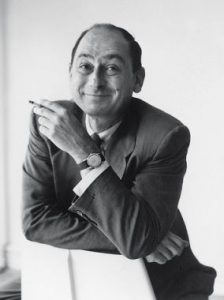
Image source:https://en.wikipedia.org/wiki/George_Nelson_(designer)#/media/File:George_Nelson_portrait.jpg
What we know about him
George Nelson was born in1908in Hartford,Connecticut. He studied Architecture atYale University, where he graduated at the age of 20 and in 1931, he also received a bachelor’s degree in fine arts. The following year, while preparing for the Paris competition, he won theRome award. With Eliot Noyes, Charles Eames and Walter B. Ford, Nelson was part of a generation of architects who found too few projects and turned to the success of theproduct,graphicandinterior design. During his life, he traveled through Europe, where he met a number of modernist pioneers, but was based in Rome. A few years later, he returned to the United States to devote himself towriting.
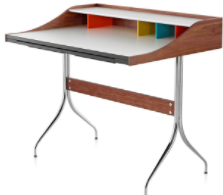
by George Nelson, from Herman Miller ®
Image source:https://hivemodern.com/pages/product1579/herman-miller-nelson-swag-desk
In 1940, George Nelson had attracted popular attention with severalinnovative concepts. One of these innovative concepts was the “storagewall“, that attracted the attention of De Pree, who was thepresident of Herman Miller. De Pree asked him to become director of design Herman Miller and this opened him a long series ofsuccessful collaborationswith Ray and Charles Eames, Harry Bertoia, Richard Schultz and Donald Knorr. From his beginnings, its office has worked for and with the best of its time. It was undoubtedly themost articulatedand one of themost eloquent voiceson 20th-century design and architecture in the United States. He was a teacher and he did write extensively, organized conferences such as the legendary Aspen meetings and he also published several books.
Info source:http://www.designindex.it/designer/design/george-nelson.html
Nelson’s best know projects
Among his best known projects, there are themarshmallow sofa, the coconut chair, the ball clock and many other products that have become milestones in the history of a profession that has contributed to shaping.
- 棉花糖Sofa
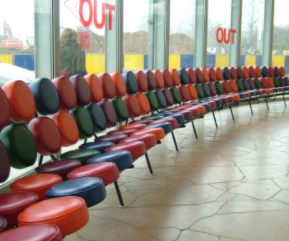
Image source:https://en.wikipedia.org/wiki/Marshmallow_sofa#/media/File:Circular.jpg
Designed by George Nelson in 1956, the Marshmallow sofa transforms the traditional sofa into aplayful three-dimensional objectwith eighteencolored cushionsconnected to a simple steel structure. Because of theunusual shapeand construction of the Marshmallow Sofa, it is one of themost extraordinary sofasin the history of design. The individual cushions are covered with a robust vinyl cover. When the Marshmallow sofa was introduced in 1956, the Herman Miller catalog described it as “The first of a series of pieces that embody a新概念in soft seating.” The warm personal and professional relationship between Nelson and D.J. DePree has produced an extraordinary range of products, from the playful Marshmallow Sofa to the first L-shaped desk, a precursor of today’s workstation. TheplayfulMarshmallow sofa is a benchmark ofmodern designthat continues to turn heads and make people smile. The 18 round cushions can all be the same color or in several colors for the right look in a private office, in a lobby, or in a living room.
Info source:https://hivemodern.com/pages/product1496/herman-miller-george-nelson-marshmallow-sofa
- The Coconut Chair
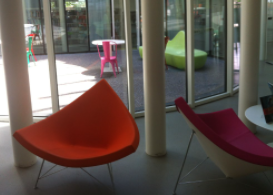
Image source:https://search.creativecommons.org/photos/dfd08d11-3243-411d-bab0-c01af450b0ecbycharlotte henard
Contemporary design for this additional cult object of design produced by the creative mind of George Nelson in 1955. This Coconut Chair, together with Marshmallow Sofa and the Pretzel Chair, enters the collection of the most famous sessions of twentieth century design history. It has entered the history of design, combiningessentialityandcomfort. Referring clearly to thecoconut shellin fact, the Coconut Chair accompanied by atouch of humoris another creation of the ’50s by George Nelson.
Adecisive shape, for this armchair with acomfortableandrelaxing seat, whose inspiration comes from a coconut cut into eight parts and with colors reversed with respect to the tropical fruit: white for the shell in plastic while the upholstery is available in various colors. The chair features a single piece offoam,upholstered leather cushionsand aplastic shellon top of three镀铬钢铁基地的腿。The Coconut Chair can be used in large spaces, large halls of the hall, but also in the private residence as a couple in the living room, or individually arranged in the study room, a prestigious presence as well as a must in the history of design for connoisseurs.
Info source:https://www.arredativo.it/2011/recensioni/salotto/cocconut-chair/
Which are the main features of Nelson’s style?
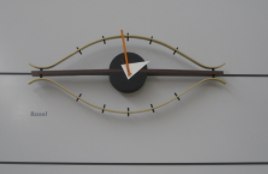
Image source:https://search.creativecommons.org/photos/d603f973-3528-494c-8da8-0e79ae3a9446bysmowblog
George Nelson’s style can be described with the following words:simplicity,imagination,intuition. Over the course of forty years, Nelson produced a body of work, both on his own and in collaboration with a talented team of associates, that includes hundreds of furniture, building, exhibition, and graphic designs, as well as nearly a dozen books and over 150 magazine articles.Confidence in progressandgrowing economic prosperitywere central aspects of the American lifestyle around 1950. Everything seemed possible, and everyone wanted to be “modern“. With the idea of bringing modern design into American homes, George Nelson created a wide range of everyday objects to furnish the home and the office, which embody the style of modern design: lamps, watches and other household accessories. Until the ’70s, Nelson’s studio continued to design many objects for the home, including the “Bubble Lamp” and the “Ball Clock“, which becameicons of modern designof the 1950s.
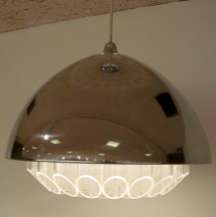
Image source:https://search.creativecommons.org/photos/3c815cb2-4644-47bb-a323-afbc810ff374byrocor
